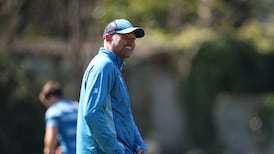As long as the Government maintain the two-metre ruling on social distancing it will not make any financial sense for the IRFU, the provinces or the ground controllers to open the Aviva Stadium to spectators on match days.
As two-metre distancing would restrict the capacity to 8,200, the ensuing gate receipts would scarcely, if even, cover the costs of opening the stadium. However, were social distancing reduced from two metres to the World Health Organisation guideline of one metre, the stadium could accommodate about 18,500 spectators, thereby making it financially viable.
"It's quite a complex mathematical operation," Stadium Director Martin Murphy told the Irish Times. "But we've done very detailed plans on how you would distribute the crowd and the seating to create that distancing and the other measures that you'd have to put in place in adhering to the guidelines."
With regard to the restricted crowd which applies with the two-metre distancing, Murphy said: “It’s frankly not viable economically. It can be done, but it just wouldn’t make any sense to do it. So we would be hoping that at some stage we will be moving to one-metre social distancing and then it becomes viable.”
The costs of hosting a game at the Aviva Stadium range from roughly €100,000 to €160,000. This would likely decrease if there were no spectators but could be higher in order to maintain social distancing and hygiene.
Costs down
“The big thing is deep cleaning, both pre- and post-match,” said Murphy. “That’s going to be a big cost, which we haven’t calculated yet and we obviously want to have enough stewards to make sure that the event is safely run while also keeping costs down as much as possible.
“The key is going to be the way the crowd behaves and buys into all measures that will have to be put in place for these matches. But I think if you look at how compliant people have been since the start of this crisis we’d be fairly confident that if we explain to people what they are required to do people will buy into it and that will make the event easier to run.
“So it’s going to be a challenge but I think it’s very important that we all get back to having crowds in the stadia. Ultimately we want to have full stadia but a halfway house would be a reduced capacity,” added Murphy, who said that playing matches behind closed doors would be “relatively easy for us to handle” if entirely new.
The Aviva is provisionally set to reopen on August 22nd with a Guinness Pro14 derby between Leinster and Munster behind closed doors. This is a fixture that would normally generate gross receipts of €1.5 million and earn Leinster over €1 million net.
The gross receipts with one-metre social distancing might still only generate a comparatively modest €500,000 or so, but that would at least make it worthwhile to open the stadium.
Three more interpros are scheduled to take place at the Aviva behind closed doors on August 23rd and the following weekend. Therefore, were outdoor gatherings in excess of 5,000 while observing one-metre social distancing approved by the Government before then, those four derbies could possibly generate in the region of €1.4 to €1.6 million.
Thereafter, Leinster and the IRFU would also hope to open the Aviva for Pro14 playoffs, the Leinster-Saracens Heineken Cup quarter-final (pencilled in for September 18th) and potentially a semi-final a week later.
Given 60 per cent of ticket revenue normally comes from hospitality and the higher cost of tickets for internationals, Ireland's game against Italy might ordinarily have yielded €3 million-plus in gate receipts for the IRFU. If it is rescheduled for October 24th, and one-metre social distancing applies, the IRFU would not generate as much from hospitality.
Yet whereas a capacity crowd restricted to 8,200 might generate €400,000 to €575,000 in gate receipts, an 18,500 attendance with social distancing of two metres would probably generate €900,000 to €1.3million.
Hence, if the IRFU host Italy and three November Tests, the difference in gate receipts based on social distancing of one metre rather two over four games could equate to nearly €3 million.
The likelihood is that the IRFU will lobby the Government to reduce physical distancing as the GAA have done, and the English RFU have done in the UK.
The RFU CEO Bill Sweeney has claimed that if social distancing were reduced from two metres to one, Twickenham could accommodate about 40,000 spectators for each of their four November tests compared to 9,000. The difference would equate to over €3.3million per game.
Gate receipts
Rugby’s financial model is much more dependent upon gate receipts than soccer, especially at club or provincial level. Leinster generate virtually 50 per cent, or €8 million-plus, of their annual income of €18 million through ticket sales. Cancelling their 13,000 season ticket sales for the 2020-21 campaign, worth roughly €4 million, left an estimated €8 million hole in Leinster’s coffers.
A third of Ulster’s €11.2 million annual revenue comes through ticket sales and they have also cancelled their season tickets. Roughly €6 million of Munster’s €17 million annual turnover comes from ticket sales and Connacht’s ticket revenue is around €2 million.
The 2020 edition of the Deloitte Football Money League showed that match-day gate receipts for Europe's top 20 clubs accounted for 13 per cent of their annual income, compared to 22 per cent in commercial revenue and 65 per cent in broadcast monies.
Barcelona (annual revenue €840.8m) generated 19 per cent of its annual income from matchday revenue, the same percentage as Real Madrid and Manchester United, whereas it was just 10 per cent for Man City.
In other words rugby needs matchday spectators more than soccer does.
Aviva Stadium
Normal Capacity: 51,700.
Restricted capacity (with two metre social distancing): 8,200.
Restricted capacity (with one metre social distancing): 18,500.





















